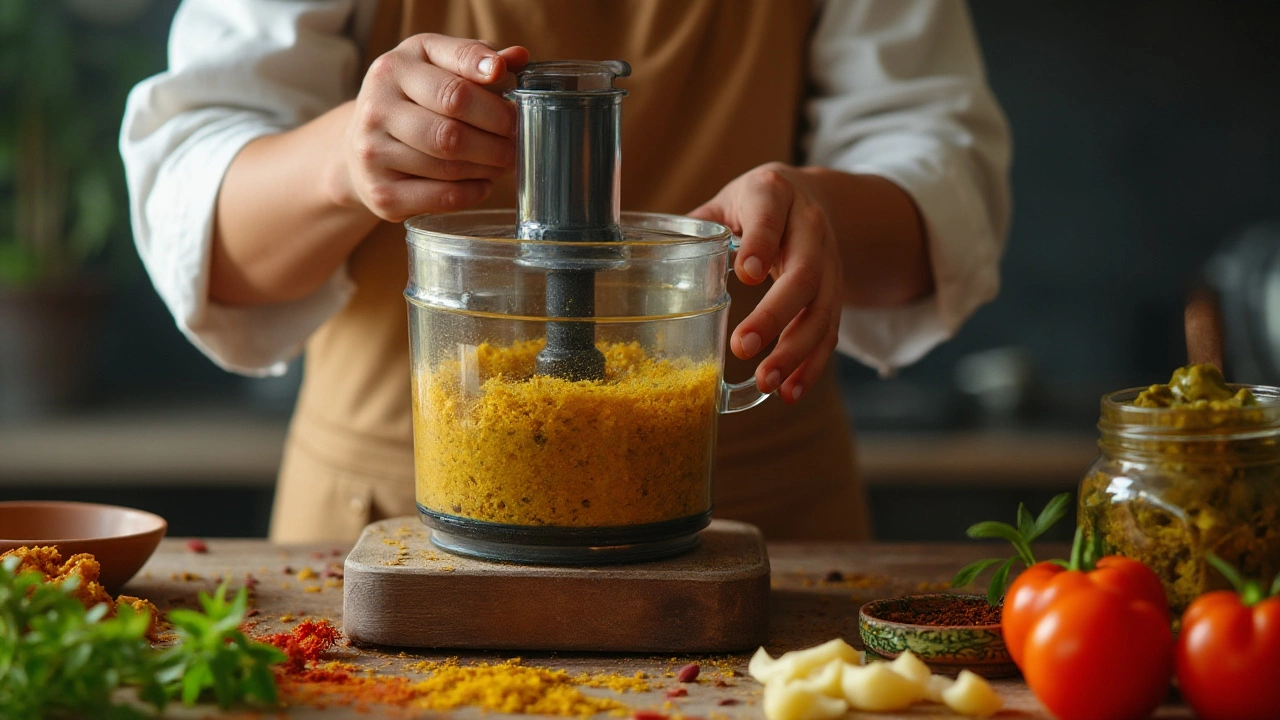Understanding the Key Drawbacks of Using a Food Processor

Food processors have revolutionized the way we prepare meals, turning labor-intensive tasks into effortless activities. Yet, like any kitchen appliance, they come with their own set of challenges that are worth considering.
One of the main issues is their size, which often requires ample counter or storage space—something not every kitchen can easily accommodate. And while they are fantastic for bulk processing, maintaining control over the finer aspects of food blending can sometimes prove difficult.
There's also the risk of over-processing, where ingredients can turn into mush far quicker than one might anticipate. This can be particularly disappointing when you are aiming for specific textures.
Moreover, cleaning these machines can be quite the chore, involving multiple parts that must be disassembled and adequately washed to ensure hygiene. Despite these hurdles, understanding these aspects can help you make a wiser choice about the appliances you bring into your kitchen.
- Size and Storage Challenges
- Precision and Control Issues
- Risks of Over-Processing
- Cleaning and Maintenance
Size and Storage Challenges
One of the most evident aspects of a food processor is its size, which can be both a blessing and a curse depending on the kitchen setup you are working with. Most food processors are designed to handle a variety of tasks from dicing vegetables to kneading dough, requiring a significant amount of power. This capability often translates to a larger footprint, something that might not harmoniously fit in a smaller kitchen or one with limited counter space. The typical design involves a broad base housing the motor, topped with a bowl and accompanying lid. When fully assembled, it can reach heights that might not comfortably tuck under low cabinets, thus becoming a permanent fixture on many countertops. The need to accommodate these dimensions can drastically influence how one utilizes their kitchen space.
Storing a kitchen appliance of such magnitude presents its own set of challenges. Kitchens often juggle the dilemma of balancing functionality with surface area, making an efficient use of space an absolute necessity. Cabinet arrangements are typically occupied with everyday essentials, leaving non-negotiable items like a food processor struggling to find a home. If stowed away, there's the recurring hassle of retrieving the processor from a distant cabinet or closet each time it’s needed for a culinary task. Prolonged stints in storage might even result in the processor not being used as often as intended, which can be considered an injustice to the device's intended utility. On this note, many users find themselves redefining their kitchen workflows to conveniently accommodate these larger appliances.
Moreover, there's the intriguing paradox of choice; the quest for an ideal food processing unit often involves weighing features against physical dimensions. While smaller models are available, these options might lack capacity or power, ultimately limiting their utility. This forces potential users to make a choice between a compact design and full functionality. As reported by Consumer Reports, "an efficiently designed food processor should blend into your kitchen environment rather than override it." This insight challenges users to evaluate how an appliance fits into an existing kitchen ecosystem rather than reshaping it entirely.
It’s worth noting the varying dimensions of food processors in the market today. Through innovations, manufacturers are keenly aware of these issues and have begun producing models that offer convenient storage solutions such as nesting bowls or a dedicated compartment for accessories. Here, a quick comparison might offer perspective:
| Model | Dimensions | Power |
|---|---|---|
| Brand A Processor | 14" x 10" x 12" | 600 Watts |
| Brand B Compact | 11" x 9" x 10" | 500 Watts |
| Brand C Mini | 8" x 8" x 10" | 300 Watts |
These advances hint at a growing trend where manufacturers strive to address consumers' space constraints without compromising on the robust capabilities that come with a full-sized unit. Therefore, anyone considering a food processor must thoughtfully assess how these disadvantages intertwine with their culinary ambitions and living environment. For those with limited space, careful planning around usage and storage can transform these challenges into manageable components of everyday kitchen life.

Precision and Control Issues
While a food processor is an asset in any kitchen, one of its notable drawbacks revolves around precision and control during food preparation. Many home cooks find that the one-size-fits-all approach taken by most food processors can be limiting, especially when working with dishes that demand exactness. For instance, achieving the perfect consistency for a pie crust, where the blend of ingredients needs to be fine yet not overworked, can be quite tricky with these appliances. Food processors may lack the gentle touch necessary for such tasks, leading to inconsistent results that can impact the final outcome.
The design of a typical food processor involves a strong motor coupled with sharp blades. This combination is incredibly efficient for rapidly chopping and processing food but falls short when considering delicate tasks. When ingredients get processed quickly, there’s little room to stop at varying stages to check for a precise chop or blend level. As a result, what you might gain in speed, you often lose in meticulous detailing. Imagine making a rustic salsa where the desired texture includes chunky bits. With a food processor, you might find yourself ending up with a puree instead of the chunky texture you desired.
Adding to these challenges is the interface design of most food processors, which often includes generic settings. These settings can mean lacking fine-tuned control over speed and intensity. Unlike a manual method where you can gauge the pressure applied, a food processor might continue chopping regardless of the desired outcome if left unattended. A study by a leading culinary institute highlighted that pressure often varies drastically with automated appliances. This disparity can turn tasks that require steady hand results, such as mincing herbs without bruising them, into a frustrating experience with a machine-flattened finish instead.
"Quality in any dish comes from the chef’s control over his tools,” remarks famed chef and cookbook author Julia Child. “A machine seems helpful until it dictates the terms of the dish for you."
While this automation and lack of tactile feedback could be somewhat mitigated by manually pulsing the processor, such intervention isn’t always user-friendly. Especially in scenarios demanding frequent pauses and adjustments, the supposed convenience of using a food processor dwindles. Devices like blenders and stand mixers often offer greater adaptability, enabling users to adjust speeds mid-operation easily, a feature not commonly at the same level in food processors.
The lack of control also extends to ingredient quantity management. Overloading the bowl is a frequent misstep, wherein users underestimate the power of the processor blades. This often results in uneven processing or even liquid seepage when dealing with wet ingredients. To ensure an even result, experts often suggest working in batches, but this can erode the time advantage a food processor claims to offer. Some modern versions attempt to address these issues by introducing various attachments or speed settings. However, the improvement remains incomplete, especially for those accustomed to hands-on precision.

Risks of Over-Processing
In the quest for creating perfectly smooth hummus or a silky puree, a common pitfall is inadvertently taking the ingredients past the point of no return. The food processor works its magic with such efficiency and speed that the line between well-processed and over-processed can become blurry in a matter of seconds. This is particularly a concern when you're dealing with delicate ingredients or aiming for textures that rely on a certain coarseness or bite. For example, when preparing salsa, you may want a chunky texture that over-processing can quickly turn into a soupy mess.
Moreover, over-processing can negatively impact the flavor profile of delicate dishes. Herbs and vegetables, rich in volatile oils and delicate flavors, can easily become bruised under the intense speed and power of an industrial-grade kitchen appliance. This results in a loss of distinct flavors, leaving a homogenized taste that lacks the vibrant nuances you might find from a more hands-on approach. For those who relish the complex interplay of different textures and flavors, this is a significant drawback.
Another aspect to consider is the nutritional loss. While using a food processor, excessive blending can break down the fibers in fruits and vegetables more than desired, potentially affecting their nutritional integrity. The fibers, essential for digestion, can become too fine, resulting in easier digestion that does not provide the gradual energy release needed throughout the day.
A chef once remarked,
The best culinary experiences come from a delicate balance—not just of flavors and ingredients, but in the way we prepare them. Over-processing with machines can strip away the essence that makes each dish unique.These words reflect an understanding that the practical benefits of technology should not overshadow the art of cooking itself.
Even professional chefs have to tread carefully, especially when crafting complex dishes where texture plays a pivotal role. It's advised to ‘pulse’ rather than run the machine continuously, giving you better control over the consistency. Paying attention to processing durations and understanding the basic operations of your kitchen appliance can indeed set your culinary experiences apart, preventing the risks of over-processing from becoming an everyday issue in your culinary routine.
Ensuring you have a clear grasp of what your recipe needs, alongside appropriately using your food processor, can help maintain the desired texture and flavor of your dish. Awareness and control remain at the heart of keeping over-processing at bay, ensuring each meal you prepare not only celebrates the vibrant flavors of its ingredients but also the artful hands that crafted it.

Cleaning and Maintenance
Having a food processor is a boon in countless ways, but when it comes to the often tedious job of cleaning and maintenance, things can get a bit cumbersome. After a delightful cooking session, reality hits when you look at all those detachable parts that need attention. Food processors typically come with several components, from blades and disks to bowls and lids, all of which interact with food and need thorough cleaning. It's crucial because even the tiniest bit of leftover food can lead to unpleasant odors or even bacteria growth if left unaddressed.
Taking on the task of cleaning a food processor starts with disassembling it. Gently remove each component, avoiding contact with sharp blades if safety matters to you, which it should. Once broken down, the washing becomes manageable but still requires some effort. All parts that are dishwasher safe should be placed away from heat elements to prevent warping. For parts that require hand washing, soaking them in warm, soapy water is effective in dislodging any food particles that might stubbornly cling to surfaces. Using a brush with soft bristles can also reach the hidden corners.
Maintenance Tips
Regular maintenance goes beyond basic cleaning. Inspect your food processor periodically for any signs of wear or damage. Over time, you might notice that the bowl may develop scratches or discoloration, which is a sign to consider replacements to keep the appliance functioning effectively. Sharpness is key to a processor's efficiency, so ensure that the blades remain crisp. A handy trick is to occasionally send some ice cubes through it to keep them sharp and ready for the next task.Storing the processor with care also extends its life. Ensure all parts are completely dry before reassembling to prevent the growth of mold or bacteria where moisture lurks. A user from a popular culinary forum once shared,
"Properly maintaining your kitchen tools can extend their life by years and enhance your culinary experience tenfold."A wise reminder to all home cooks. Remember, for cord storage, gently coil it to avoid kinks and potential damage.
In an occasional survey conducted among home chefs, over 60% admitted that the cleaning process was their least favorite aspect of using these devices. Yet, with a meticulous approach and regular maintenance schedule, these concerns can be minimized, and your beloved appliance can continue to serve you deliciously well-prepared meals for years to come.





